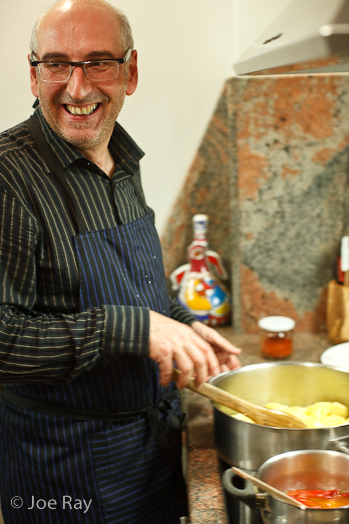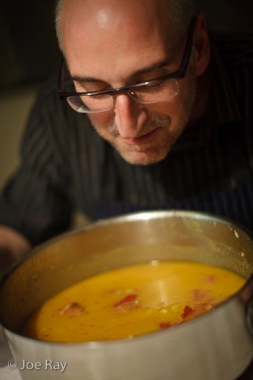Rioja region’s dish mixes potatoes, chorizo, and care
The Boston Globe - Food & Travel - Wednesday March 3, 2010


LAGUARDIA, Spain - The quest begins on a tip from a Catalan friend. “While you’re in Rioja, you need to eat patatas a la riojana,’’ he says, referring to the region’s signature dish, a stew-like mix of local potatoes and the region’s native son, chorizo. He sends me looking for a man in a castle in the hilltop town of Laguardia.
“That guy’s a phantom,’’ one local tells me. “He’s got a room in his hotel called ‘Love and Madness.’ ’’
Sure enough, at Castillo El Collado, Javier Acilonna appears from nowhere, his shoulders hunched inward under an oversized suit. In a movie, his entrance would have been accompanied by a flash of lightning and a thunderclap. “Come,’’ he says, ushering me toward the kitchen.
Acilonna is no phantom. He’s a kind and hard-working hotelier in this Basque corner of the Rioja region, in northeastern Spain. His riojanas, also simply called patatas con chorizo, are a spiritual cousin to paella, pulling flavors from the ingredients and transferring them to the starch. “The potatoes must come from a dry climate,’’ he says, equating the spuds to the region’s trademark wine; a tough growth cycle yields a better grape. “It gives more flavor and they cook better.’’
He demonstrates a peculiar method for cutting the potatoes; he uses his paring knife to cut partway through before giving the handle a twist and breaking off a thumb-size irregular chunk. In the pot, his potatoes, which come from a handful of growers in the nearby Alava region, absorb the flavors of chorizo, dried piquillo pepper, fresh bay leaves he has grabbed from a tree out front, and the meat and bone of a single pork rib.
He combines all of these in a stockpot, brings it to a boil, and lets it bubble away until the potatoes are tender. In a separate pan over high heat, he pours in enough olive oil to generously coat the bottom of the pan and adds finely diced onion. He lets that sizzle away for half a minute, tossing it constantly, before removing the pan from the heat and stirring in a tablespoon of paprika. He tips the paprika mixture into the pot of potatoes.
“We use paprika in everything,’’ Acilonna says, “but my secret is in another ingredient: cariño (care).’’
It sounds a bit like what the French would call la soupe. But when he spoons up a taste from a bouillabaisse-like tureen, it’s easy to understand why the dish is so famous in the region.
In nearby Logroño, I go to try the potatoes on the Calle del Laurel, where there are a bewildering number of tapas bars, including places so specialized that they only make one or two items. It’s pure foodie heaven, but there are no riojanas. “There’s no mythical site for them,’’ says winemaker Juan Carlos López de Lacalle. “You have to make them at home.’’
For his potatoes, cariño surfaces again as López de Lacalle makes a batch with his wife, Pilar. “Breaking the potato with the knife makes a rough surface so more starch is exposed,’’ Lopez de Lacalle says. “If you just cut straight through, it’s too smooth.’’ It also adds texture and, some say, allows the potatoes to absorb more flavor. “You can still mess up the dish even if you use good potatoes,’’ Pilar says, “but if you use bad potatoes, you’re in trouble.’’
It’s beautiful to watch them cook together, pausing for the occasional toast or a kiss, even though their cooking styles vary slightly. After he adds the water to the stockpot, she adds a bit more when he’s not looking.
López de Lacalle’s recipe is markedly different from Acilonna’s, most notably in that he gently sautes the potatoes with a bit of garlic to begin, then continues stirring often until they’re done, slowly breaking the rough corners from the potatoes and giving the liquid the consistency of split pea soup.
The winemaker has the patience to devote to this dish. He drinks his own Rioja wine, holding the glass stem and inhaling with his eyes half closed. At the table, when he takes the lid off of his riojanas, his glasses are fogged by the steam.
We tuck in and López de Lacalle starts singing, clearly pleased with his own cooking. The wine goes with the dish as if it were made to. And it was.
Castillo el Collado, Paseo el Collado, 1, Laguardia, Spain, 011-34-945-62-12-00, www.hotelcollado.com Artadi Wines, Ctra. Logroño s/n. 01300 Laguardia, 011-34-945-600-119, www.artadi.com
Patatas a la Riojana
4 russet or other baking potatoes
1 thick pork loin chop on the bone
1 dried red pepper, seeds removed and crumbled into several pieces or 1/4 teaspoon crushed red pepper
2 bay leaves
1/3 pound chorizo, cut into 1/2-inch pieces
Salt, to taste
3 teaspoons paprika
2 tablespoons olive oil
1/2 onion, coarsely chopped
1. Peel potatoes. Cut them into bite-size pieces by inserting blade of a paring knife about 1/2 inch into the potato and twisting the handle to break off each piece. (Some pieces will be larger than others.)
2. Remove the meat from the chop and cut it into 1/2-inch pieces. Set the meat and bone aside.
3. In a stockpot, combine the potatoes, pork and bone, red or crushed pepper, bay leaves, chorizo, a generous pinch of salt, and 1 teaspoon of the paprika. Add water to cover.
4. Bring to a boil and lower the heat. Simmer, uncovered, for 25 minutes or until the potatoes are tender.
5. Meanwhile, in a skillet, heat the olive oil over medium heat. Add the onions and cook, stirring often, for 8 minutes or until softened. Stir in the remaining 2 teaspoons paprika and cook, stirring, for half a minute.
6. Scrape the paprika mixture into the pot of potatoes. Cook, stirring often, for 5 minutes or until the broth is flavorful. Remove the pork bone and bay leaves. Taste for seasoning and add more salt or crushed red pepper, if you like.
Serves 4